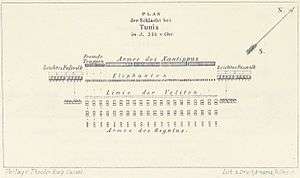Battle of Bagradas
| Battle of Bagradas | |||||||
|---|---|---|---|---|---|---|---|
| Part of the First Punic War | |||||||
 | |||||||
| |||||||
| Belligerents | |||||||
|
|
| ||||||
| Commanders and leaders | |||||||
| Xanthippus | Marcus Atilius Regulus (POW) | ||||||
| Strength | |||||||
|
16,000 12,000 Infantry 4,000 Cavalry 100 Elephants |
15,500 15,000 Infantry 500 Cavalry | ||||||
| Casualties and losses | |||||||
| 800 killed |
12,500 12,000 killed 500 captured | ||||||
The Battle of Bagradas, also known as the Battle of Tunis,[1] was a Carthaginian victory over Rome in the spring of 255 BC during the First Punic War.
Prelude
The mercenary Spartan general Xanthippus was hired by the city of Carthage following heavy-handed negotiations by Rome. He made the Romans fight on open ground, which allowed him to maximise the effect of the excellent Carthaginian cavalry and elephants.
The Roman army under Marcus Atilius Regulus was based at Tunis. Faced by the resurgent Carthaginian army, Regulus was keen to gain another victory rather than risk the chance that someone else would get the glory of eventual victory.
Deployment
Xanthippus deployed the Carthaginian phalanx in the centre, mercenary infantry on the right, a line of elephants in front of the infantry, and the elite Carthaginian cavalry split between the two flanks. The Carthaginians had 12,000 infantry, 4,000 cavalry, and 100 war elephants. The Romans had 15,000 infantry and 500 cavalry. The Romans were formed in their normal formation, with the legionary infantry in the centre and the outnumbered cavalry on the flanks.[2]
The battle

The Carthaginians started the battle with an attack by the elephants. This tied up the main force of Roman infantry. The Roman cavalry, outnumbered eight to one, was quickly defeated. Only on their left did the Romans have any success, when 2,000 troops, possibly allied troops, defeated the mercenaries facing them, and chased them back past their camp. Meanwhile, in the centre the elephant attack had been withstood, but only a few isolated units of Roman infantry managed to get past them to attempt to attack the Carthaginian phalanx, and those were quickly defeated. Finally, the Carthaginian cavalry charged the already shaken Romans from both sides, destroying what cohesion was left. Only the 2,000 troops successful earlier in the battle escaped to be rescued by the Roman fleet.[3][2]
Aftermath
The Romans lost 12,000 killed and 500 captured, while the Carthaginians lost only 800 mercenaries killed.[3][2] Regulus himself was taken prisoner. Some later Roman writers claim that his eyelids were cut off and he was trampled to death by an enraged elephant.[4] However Polybius does not mention it and Diodorus, (a writer hostile to the Carthaginians) implies he died from natural causes.[5] The defeat, and serious disasters in storms at sea, ended any chance that Rome would defeat Carthage in Africa, and ensured that the rest of the war was fought in Sicily and at sea.
Citations
- ↑ Lost Battles, Philip Sabin p174
- 1 2 3 Rankov 2011, p. 157.
- 1 2 Lazenby 1996, p. 106.
- ↑ Kistler, John M. War Elephants. Westport, CT: Praeger, 2006. p.100.
- ↑ Carthage and the Carthaginians, R Bosworth Smith.
Bibliography
- Lazenby, John Francis (1996). The First Punic War: A Military History. Stanford, California: Stanford University Press. ISBN 0-8047-2673-6. OCLC 34371250.
- Rankov, Boris (2011). "A War of Phases: Strategies and Stalemates 264–241". In Hoyos, Dexter. A Companion to the Punic Wars. Oxford: Wiley-Blackwell. ISBN 978-1-405-17600-2.
